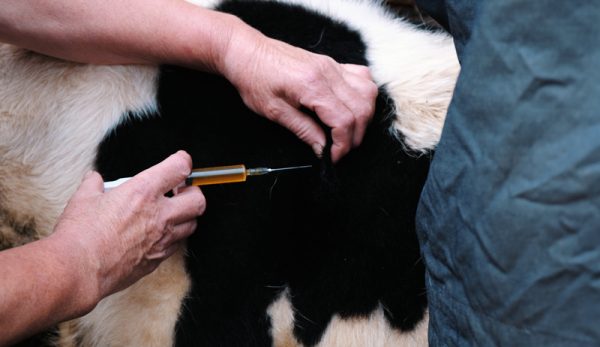
This is the first of a three-part series covering basic safety tips for administering common medications to your livestock. This month we’ll cover injectable products.
Those new to hobby farming might be surprised to learn that there are in fact many different injectable products you can give your animals without a veterinarian. A few injectable products available over the counter at your local feed store include:
- Vaccines (like tetanus)
- Antibiotics (like penicillin)
- Some vitamin/mineral supplements
This accessibility is ideal for short-term and simple health issues. But the first step in making sure a drug works to the best of its ability is to ensure that it is administered properly.
Proper Storage
First, let’s consider proper drug storage.
Many injectable products require refrigeration between uses; some also need protection from light. Check the label for exact storage requirements and expiration date.
You can rely on the general rule of thumb that any vaccine needs refrigeration. This goes for penicillin, too.
A mini-fridge is a great asset in the barn for this purpose, but make sure it’s in good working order. Discard any injectable drug that becomes accidentally frozen.
Administration
Now let’s talk about “giving a shot.”
There are two primary routes of administration for likely animal injections:
- under the skin (subcutaneously, or sometimes “SQ” or “SC” for shorthand)
- within the muscle (intramuscularly, or “IM”)
You absolutely need to know the required route for a product you plan to give. With some drugs, incorrect administration may result in severe tissue damage and/or abscess formation and infection. The correct method of administration will be on the label.
If you’re unsure, always check with your veterinarian.
Read more: This video provides some tips for giving an injection to a lamb.
Needle Matters
Next, what about needle size? In general, the larger the animal, the thicker the skin and the larger bore needle you will need. This is called the needle’s gauge, sometimes abbreviated “G”. The smaller the bore, the larger the gauge number.
A 25 gauge needle is very fine and used for kittens and puppies. A 16 gauge needle, however, is much larger and suitable for large steers and cows. 18 gauge needles are commonly used for calves and small ruminants.
Needles come in different lengths as well.
And what about syringes? I recommend purchasing specific “Luer-lock” syringes. These syringes screw into the hub of the needle instead of just popping on. The secure lock of the screw ensures that the needle doesn’t “jump” off the syringe when you try to inject a particularly thick liquid or inject something quickly.
Luer-lock syringes cost a bit more than normal syringes but are worth it. They can prevent potential drug wastage and mis-dosing, as well as prevent caustic products from getting splashed backward into your face and eyes.
Location, Location
Injection location is also very important. For cattle, most injections are recommended in the side of the neck, but for swine, behind the ear is the best place.
On animals that will eventually go to slaughter, injection location is especially important, as you never want to inject a substance in a large piece of muscle destined for human consumption. Damage to this tissue can lead to condemnation and considerable edible tissue loss at slaughter.
Make a practice of not sharing needles between animals (often done for cost purposes). Sharing a dulled needle already used to poke through thick and sometimes dirty skin can easily cause abscesses or other tissue reactions. Farmers who use clean, sterile needles for each animal and appropriate size and administration methods see far fewer abscesses and tissue reactions that those who do not practice good aseptic technique.
Injecting into clean, dry hides is best practice, too.
Stay Safe!
Lastly, what about your own safety? Some hobby farmers are simply uncomfortable giving shots. They prefer a veterinarian or other experienced individual do so instead, which is perfectly fine.
However, if you gain experience and grow comfortable in your technique, you should also consider that needles on the farm present a health hazard to you and anyone else. If you use injectable products on the farm, always keep a needle-proof container to place used needles. You can use a specific container from a medical supply store or, more cheaply, a thick plastic or metal container with a screw-on lid. Once full, cap it tightly and dispose of it.
Keep all unused needles and syringes in a dry, clean location. Keep drugs according to their label conditions and stay aware of expiration dates.
Some drugs also have limits on the number of needle punctures the stopper can withstand. These products have a place on the label to mark how many punctures have occurred.
A calculator at the barn is also handy for calculating doses. Same regarding a quick reference chart for those pesky conversions between pounds and kilograms.
With these tips you can make giving injections safer (and less painful) for your animals. Next month: oral and topical medication safety.




